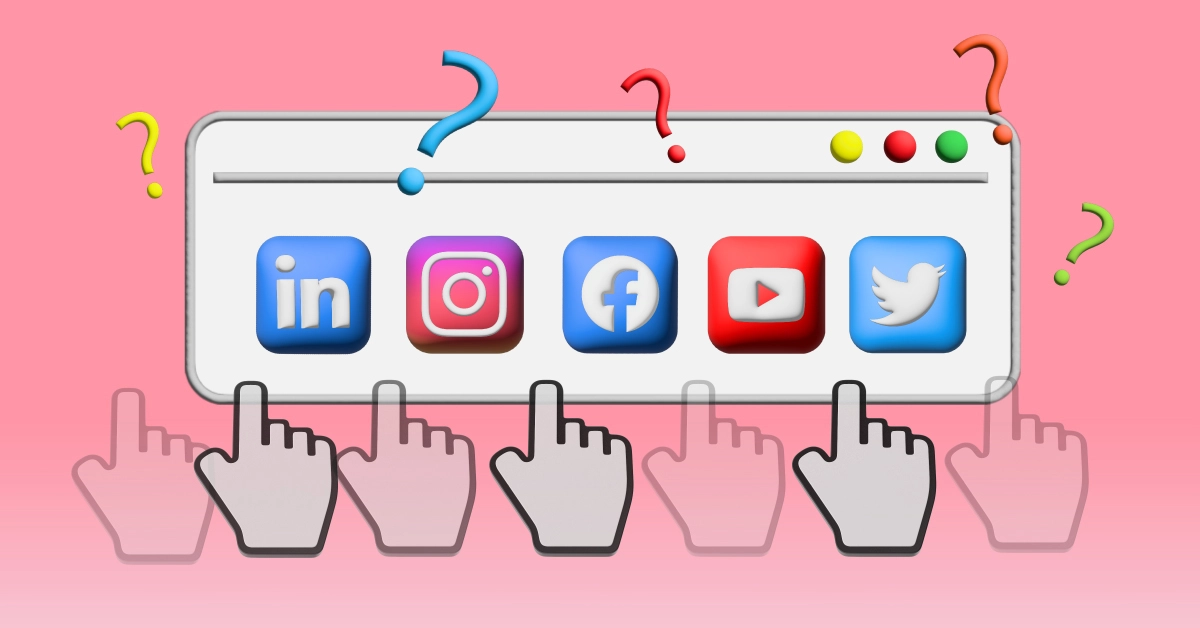
New social media channels are continually thrusting their way into the online environment to compete for audiences with platforms that have, in 21st century terms, been around for a pretty long time. So the answer to the question “What social media should a business use?” is an ever expanding one.
Well, let’s make a start. Social media can promote a business’s online presence and play a critical part in a marketing plan to boost brand awareness.
The day-to-day running of social media accounts can involve replying directly to questions about products and services. It also means delivering content that engages with a social media channel’s audiences and potentially attracts new customers.
Making the choice
From Facebook to YouTube, there are many social media platforms to choose from, and businesses may feel like they need to be on all of them.
So is this a good idea?
Probably not. Once on a platform, it is important to keep a continuous presence by posting regular content, which takes time and planning. Non-appearance gives a negative impression and the channel’s users might begin to ask questions such as:
“Has this business got nothing to say for itself?”
“Don’t they value engagement with us?”
They might even conclude that:
“They’ve probably gone out of business.”
Engaging campaigning
We believe that it is invariably much more effective to run a focused campaign aimed at specific target audiences and demographics rather than communicating across many channels. This scatter-gun approach can lose impetus with the audiences that really matter.
So a business needs to decide who they want to talk to and how they want to engage with their audience in order to get their messages understood and valued. The content, both written and visual, produced for whichever channels are selected, needs to be specifically tuned in to their audiences.
Social media marketing is all about engagement, which is not achieved simply by declaring how great your company is. Social media channels give you the opportunity to prove it in many fascinating and exciting ways.
Lord Reith, the first Director-General of the BBC, strongly supported the aims of public service broadcasting, namely to “educate, inform and entertain.”
The same can apply to quality content broadcasted on social media. Some ideas still stand the test of time!
The platforms we all know about
Here are some of the well-known mainstream social media platforms that a business may think about using:
Facebook
Facebook is an extremely popular social media network and had an audience of 2.9 billion active monthly users in 2022. Facebook is a great place to share everything from photos to essential company updates. Business pages offer a wide range of options, such as being able to highlight contact information, hours of operation, the products and services offered, and much much more. This platform works particularly well for businesses selling to consumers, especially if they are able to tap into groups relevant to their products or services.
LinkedIn
LinkedIn is a very business orientated platform, where businesspeople are able to share company updates and build business connections. Company pages are great for sharing case study stories and content aimed at other business owners. A brand wanting to give their audience an insight into company culture and share any networking events should think about using LinkedIn. This is because there are 65 million decision-makers on the platform, and having the opportunity to interact with them could be extremely beneficial.
Facebook and LinkedIn can together bring in the business
Here’s how BBI Brandboost helped an exceptional school local to us in High Wycombe Buckinghamshire to bring businesses and community organisations to use its facilities, producing much needed revenue to fund educational priorities for its pupils. Take a look at how using Facebook and LinkedIn achieved terrific results.
Twitter
With Twitter having a 280-character limit it is best used for snappy, quick and to the point content. With tweets quickly disappearing on an ever-updating timeline, they have a short lifespan and the platform has become a place for industry news items. With this in mind shorter and more precise tweets are what work best for shareable content.
Growing a rapid following
Here’s how Twitter can achieve a huge expansion in followers in a short time. This relates to a targeted campaign devised by BBI Brandboost …
In July 2020 our client, a high quality precision engineering and electronics company had just 368 followers. By April 2023 their following had grown to 4,327 – a 1,075% increase!
Instagram
Instagram had more than 1.1 billion active users in 2022. From Instagram Live to Instagram Stories, there is a plethora of Instagram business tools that help brands promote and sell their services and products. This platform is a visual platform, making it an excellent tool for businesses with strong visual content to share. A high quality instagram account will be eye catching, engaging and be able to get a message across through an image.
YouTube
YouTube has become a platform for sharing information via video and now has 2 billion monthly users. It is not just a place for entertainment but also for learning about new innovations and developments.
The idea that users want to learn can make YouTube a powerful tool for businesses. It gives content creators the opportunity to create a video channel and share informative pieces such as tutorials, how products work and a whole lot more.
Complexity made simple and attractive
A short video can be a great way to portray complex business operations. For a transport & logistics company client, we produced this video to show how they monitor and care for the valuable assets of their customers. Please take a look.
The emergence of new platforms

Social media is constantly evolving to satisfy the needs and interests of the public and niche markets. New social media platforms emerge to serve specific audiences or to offer something unique.
For example, a little known app called TikTok was released in 2016 and quickly transformed the social media landscape through its short videos. It has become one of the most-downloaded apps in the world.
But isn’t Tik Tok a bit dodgy?
Well, there have been recent concerns about data security with Tik Tok, but nevertheless its success shows the impact that new platforms can have.
Here are just a couple of other new social media platforms to look out for:
BeReal
BeReal is an app produced in France with the aim to create “a new and unique way to discover who your friends really are”. It works by sending a notification at a random time every day, telling the user that it is time to be real.
The user then has 2 minutes to snap a photo of whatever it is they happen to be doing. There are no filters and no editing, making it “real”.
By the end of 2022 the app had been downloaded over 85 million times, and other platforms such as Instagram took note and created their own version of this feature. It will be exciting to see how this platform grows and how businesses can use it.
Mastodon
After Elon Musk took over Twitter downloads of Mastodon jumped 6,000% and it is certainly seen by some as a Twitter alternative that should be on a marketer’s radar. It may have a smaller number of users right now but it does have the one thing Twitter fans have been calling for: an edit button! That sought-after functionality alone should entice more people, as word spreads.
Social media pitfalls

While social media is a great place to reach a larger audience and increase brand awareness, there are potential dangers out there. These include:
Decline in brand reputation:
To avoid damage to a brand, a business must be respectful of its audience and think very carefully before clicking the post button. Insensitive posts have caused controversy for many companies in the past including fast-food chain Chick-fil-A, who received backlash after a tweet posted from a company account sparked accusations of racism in September 2022.
Lack of information:
Businesses can feel like they just have to get onto social media as soon as possible, and end up setting up accounts of every social media platform they can think of. We warned about how a lack of focus earlier can lead to Incomplete or outdated social media pages that will reflect poorly on a business; a company Facebook page that has not been updated in a year is no way to represent a brand.
Overuse:
On the other hand, some social media accounts can post too much and end up overwhelming their followers with too many posts that are tedious or unnecessary. Furthermore, some really good and engaging content may be missed by users if there are too many other meaningless posts either side of it.
Hacking:
Social media platforms or individual accounts can be hacked and cause businesses problems. Hackers can compromise the integrity of a product or service, leading to mistrust from customers. Even major businesses have fallen victim to the threat of online hackers, as seen when Burger King’s Twitter page was hacked in 2013. Therefore it is important that companies safeguard against cyber threats.
Social media tips

Yet with all this information, and with everything known about each platform, the main priority to consider before launching a social media campaign is knowing where and who your audience is. With this in mind, here are a few other things that should be considered when posting on social media:
- Is it on brand?
- Does it offer value?
- Will it be engaging?
- When is the best time to post?
- Does it fit the platform it is being posted to?
At BBI Brandboost, our social media management skills can be used to develop options for social engagement tailored to suit a wide range of budgets and business requirements. We will be able to help determine which social media platforms your business should be using.
If you found this article helpful, please share it. Also, we would really welcome your feedback on this post and your experiences of using social media for your business. And, of course, please contact us now to find out more about this topic and how it impacts on business. Thanks for your interest!